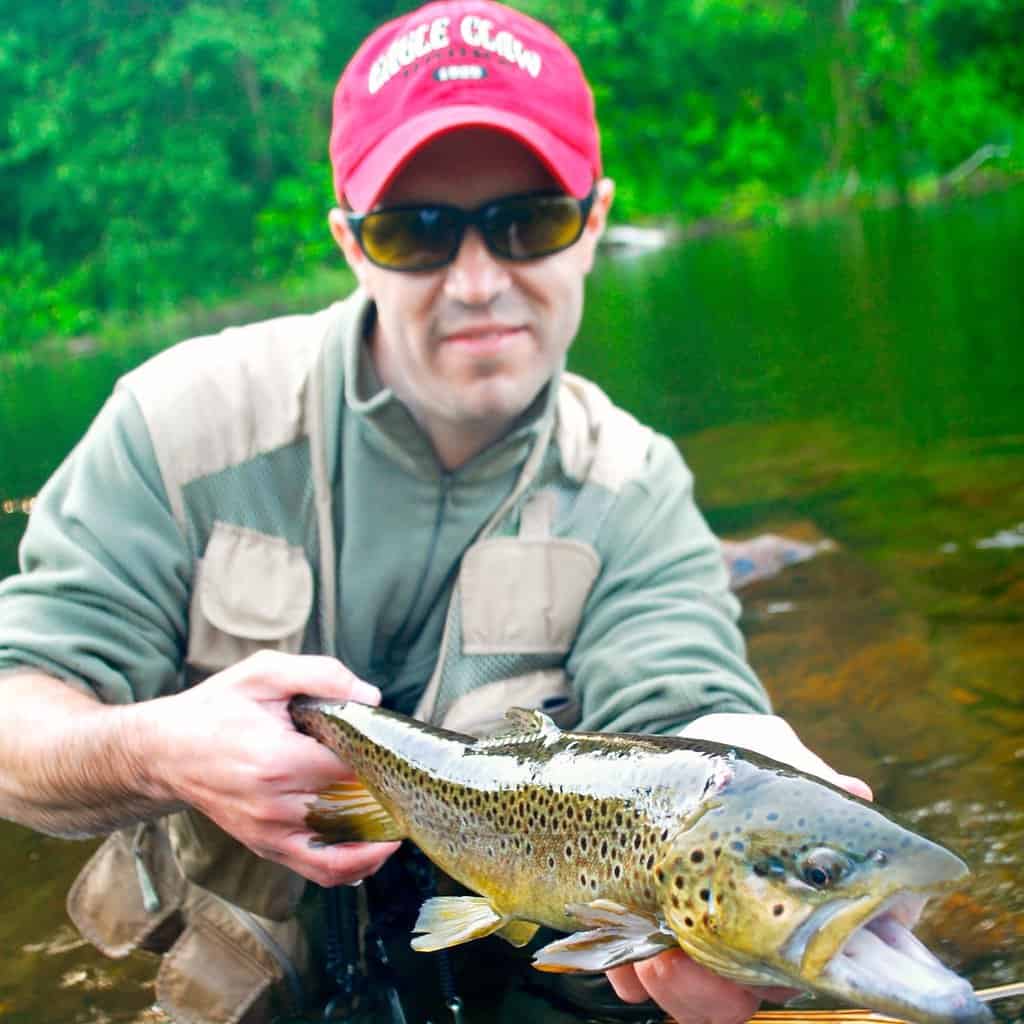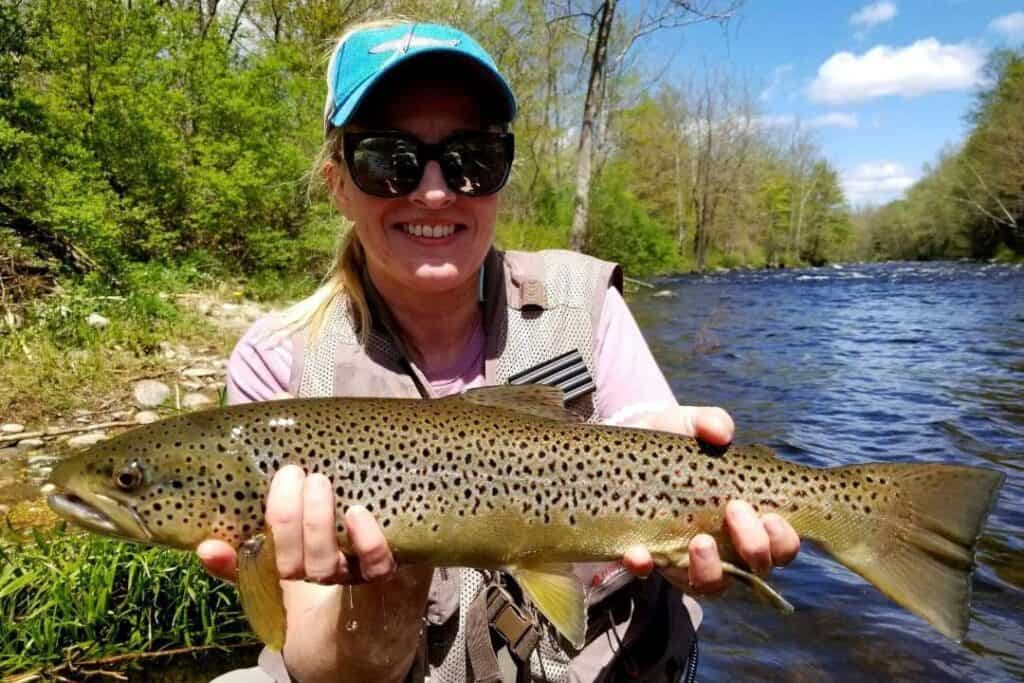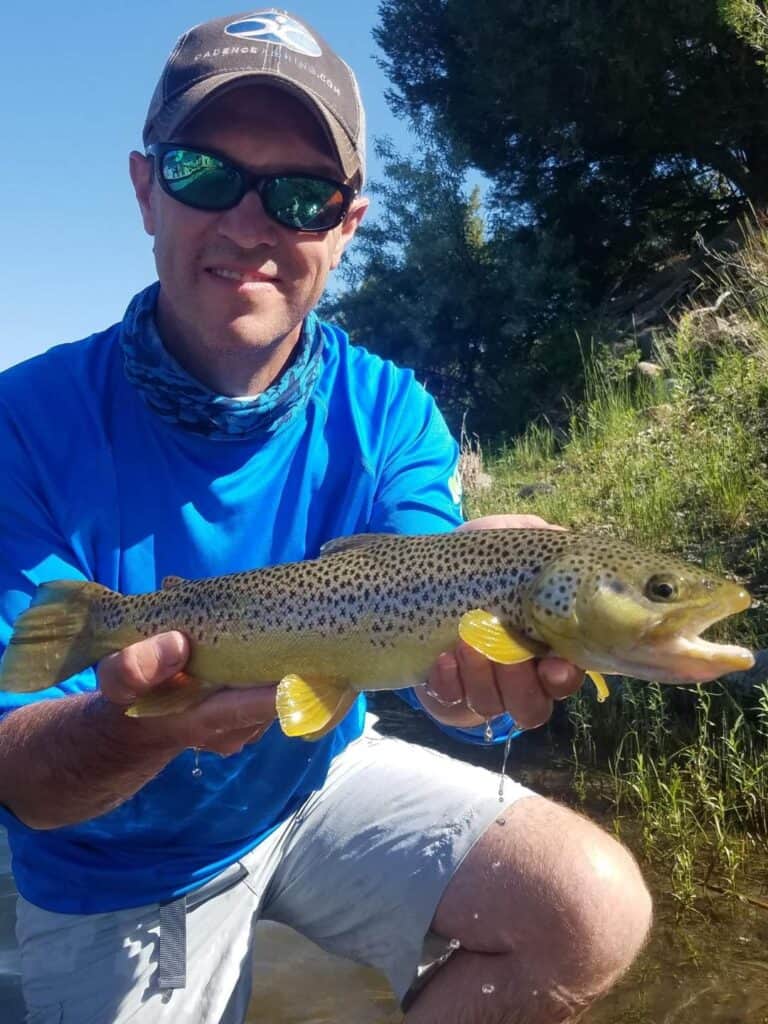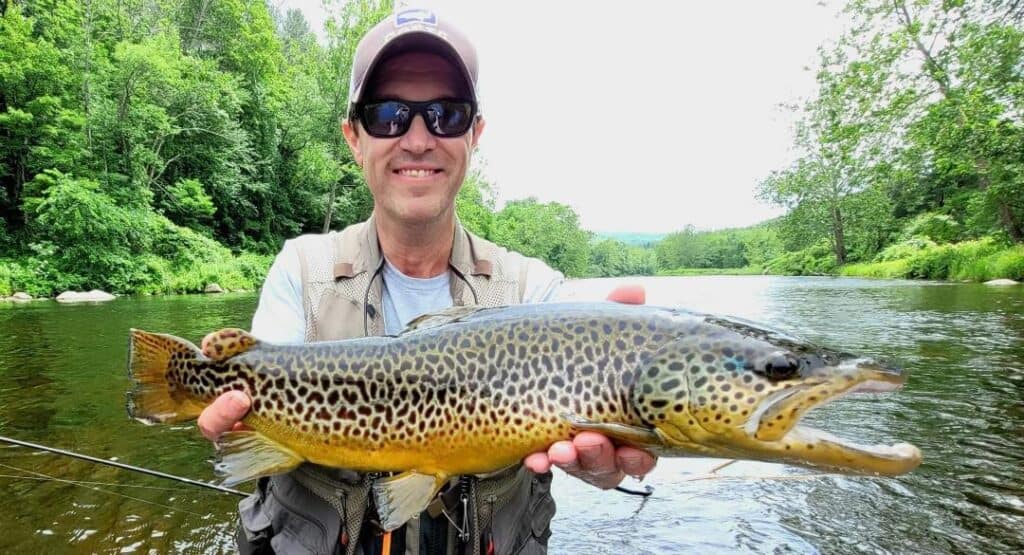Summary: This article will show you the very best trout fishing rivers, lakes, and ponds in Connecticut. With the help of a local expert and our own angling guide, we reveal some of the best ways to land the state’s surprisingly accessible trophy trout.
If we told you there’s a state where you can catch 20-plus-inch brown trout on wadable streams with ultra-light gear, you might be thinking of one of the Great Lakes states, somewhere out West, or even in the Midwest.
Connecticut probably wouldn’t be the first state that came to mind.
That’s exactly why the rivers in one of the nation’s smallest states are so incredible: In Connecticut, you’re not competing with anglers from all over the world to fish a body of water that’s become a household name.
For many Northeast anglers, these bodies of water are a day trip away and can rival some of the most incredible trout fishing anywhere in the country.
Thanks to local expert Matt Wettish, we’ll dive into fishing three of Connecticut’s best trout rivers.
Then we’ll take you on a tour of some of the best of the many lakes, ponds, rivers, and brooks that can offer excellent trout fishing in Connecticut. We’re pretty sure there’s one or more near you.
The Connecticut Department of Energy and Environmental Protection’s Fisheries Division stocks many of its waters across the state with trout, including large numbers of rainbow and brown trout. In some places, the state plants brook trout, tiger trout, Atlantic salmon or kokanee salmon.
For more trout fishing techniques and tips, check out the suggestions throughout this article as well as in our simple trout fishing guide linked near the end of this article.
3 Best Trout Fishing Rivers in Connecticut
The following three rivers offer some of the best trout fishing anywhere in Connecticut, according to Wettish, a longtime state resident, expert angler, and host of the Real Outdoors TV channel on YouTube.
Be sure to also check out our supplementary list of additional rivers and brooks that are generously planted with hatchery trout. There’s probably one just up the road.
Farmington River
At the top of our list is the Farmington River, which offers fishing for brown, rainbow, and brook trout in long stream stretches.
The trout you’ll always remember tend to be the browns. The brown trout that Connecticut stocks are considered a “survivor” strain.
Fisheries staff electroshocks the river each spring and chooses the fattest, healthiest fish to bring back to the hatchery to breed. The goal is to use the genes from the river’s best trout to create the hardiest fish to stock the following year.
The program seems to be working.
“My largest fish on the Farmington was a 24 ¾ – inch brown trout,” Wettish remembered. “But there was a time when I had a fish on for more than 25 minutes and never saw it and never had control of it.”
The Farmington is a river with some truly enormous trout. Wettish provided pointers for finding its fish. He remembers the old days when anglers bought DVDs with maps that showed features in a body of water like the Farmington.
These days, Wettish turns to newer technology like Google Maps to find likely holding spots for big trout.
“You look for little waterfalls and pools and things like sharp corners, any dramatic turn that is going to create slack water or an eddy, and that’s where you’ll find fish.”
The Farmington certainly has public access points, like the handicapped-accessible angler’s area opposite the intersection of Albough Road and Route 181 in Pleasant Valley, just north of New Hartford.
However, Wettish stressed that if you’re able, you should get a little hiking in to reach areas that aren’t so heavily fished.
“If you go to that spot by the road where everybody fishes, and walk in a half mile, where nobody’s fishing, that’s going to make a difference,” he said. Wettish uses polarized glasses to help find changes in water color that signal deeper water where larger fish will be holding.
Wettish advised anglers to consider how a river moves at four different speeds. There are various speeds at any stream’s surface, bottom, middle and bank edges.
Knowing about changes in river speed is crucial because anglers who match the natural current while drifting lures, flies, or bait will be the most successful.
“The trick is to present that bait, no matter where it is, shallow, deep, turbulent, at a speed that matches the natural speed of the water it’s moving through,” he said. “It all comes down to understanding the speed of the water, and how it affects your bait.”
Wettish was primarily a fly angler before adopting an ultralight presentation using live mealworms that trout can’t resist. An article in Field & Stream dubbed him the “Mealie Master.”
His mealworm method is a stealth approach, deploying 2-pound-test fluorocarbon and a size-12 scud hook. The ideal size mealworms are larger, about three-quarters of an inch in length.
Wettish fishes the mealworms either weightless or with up to three BB-sized split shots (the smallest size). As needed, he adds weight 12 and 36 inches above his hook, depending on the depth and speed of the current.
Before he pretty much settled on fishing mealworms, Wettish also caught plenty of trout in the Farmington River using conventional tackle.
“Roostertails, especially the old firetiger pattern, worked really well,” he remembered. “The rainbow trout and brown trout patterns, and the one that was brown and pink with black dots, those were particularly effective.”
When targeting larger fish, he’d fish a silver-and-black Countdown Rapala in Size 1 (one inch), the smallest one the company made.
State hatcheries stock the Farmington River with large numbers of trout in multiple sections. Rainbow and brown trout are the most numerous and often are larger fish. You also have a good shot at catching stocked brook trout and you might catch one of the smaller numbers of tiger trout. (Tiger trout are a cross between brook and brown trout.)
In the Trout Management Area, anglers can harvest two trout per day from the opener in April through August. After that, fishing is catch-and-release for the rest of the year.
Check out the regulations for all the details before fishing.
Salmon River
Another good option for Connecticut trout anglers is the Salmon River, designated as a trophy trout stream for the entire section that runs near Colchester, East Haddam, and East Hampton.
It’s worth noting that there are sections, as per Connecticut state regulations, that are fly-fishing only. So make sure to understand the rules before you set out.
The Salmon flows through the Salmon River State Forest and the Wopowog Wildlife Management Area. Both areas are heavily shaded with forests to help to keep the river cooler during summer months.
Determined anglers can find a few native brook trout in the tributary streams of the Salmon, but they’re few and far between.
Much more common in the Salmon than the natives are the generous numbers of rainbow, brown, and brook trout raised in hatcheries and stocked as adult fish. There are some tiger trout stocked as well.
Many of the trout planted in the Salmon are larger fish of 12 inches or more.
At the Salmon River State Park, a designated Trout Management Area is popular among Connecticut anglers and a quick drive from Hartford. River Road runs along the Salmon and makes fishing fairly accessible.
The Salmon features every kind of trout habitat, from faster, oxygenated riffles to deeper pools where holdover trout can survive warmer days and cooler late-fall nights.
Without a doubt, spring is the best time to catch trout in the Salmon River.
“April, May, and June are the best, and the Salmon is stocked so heavily,” Wettish said.
By late June and definitely into the rest of summer, anglers have caught the majority of planted fish. And the warmer, lower stream flow makes catching any surviving trout much more difficult.
Housatonic River
The Housatonic is a third river worth checking out if you’re targeting Connecticut trout.
The river changes substantially along its course from where it flows out of Massachusetts into northwestern Connecticut compared to where it dumps into Long Island Sound.
The section of the river in the northern part of the state near the Route 7 crossing is where you’ll find your best shot at colder water and better trout fishing.
This upper stretch of the Housatonic River is a Trout Management Area, and it’s worth noting that a three-mile section is open only to fly fishing.
You can find several places to fish the river from either Route 7 or River Road, which run along the banks of the Housatonic.
As with the Salmon River, spring is the best time of year to fish the Housatonic, when the stocking trucks visit and the water is cool.
Besides trout fishing, the Housatonic has some excellent smallmouth bass fishing in some stretches.
Upstream, the Housatonic is among the best trout fishing rivers in Massachusetts.
11 Top Trout Fishing Ponds and Lakes
The Connecticut DEEP stocks dozens of lakes and ponds with trout across the state.
We’ve curated a list of locations that stand out as some of the better options due to the good numbers of planted trout and additional angling opportunities.
That said, the number of still waters with very good trout fishing potential is quite long in Connecticut, so be sure to check out the longer list we provide below.
Beach Pond
The state heavily stocks this pond on the border of Rhode Island and Connecticut with brown trout.
It’s common for Connecticut to put in more than 2,000 browns, including many 12 inches or longer.
As a potential bonus, the state has experimented with stocking kokanee salmon in Beach. These landlocked sockeye salmon native to the West Coast have only been planted on an experimental basis in a small number of Connecticut waters.
Anglers can fish for trout year-round.
Other fish you might catch include largemouth and smallmouth bass and chain pickerel. The lake also produced a state walleye record.
Crystal Lake
Crystal Lake, east of Ellington, gets a healthy stocking of brown and rainbow trout. Among the trout are plenty of 12-inch-plus browns.
A bonus for Crystal Lake anglers is that the state has experimented with putting Atlantic salmon in this body of water, so there’s always the chance for a beautiful surprise species.
Highland Lake
This Winchester-area lake is another Connecticut favorite among trout anglers, likely because the state stocks rainbow and brown trout here by the many thousands.
Plenty of larger trout are planted at this northwestern Connecticut lake, including a modest number of nice brook trout to add variety.
Amos Lake
Amos Lake near Preston, in southeastern Connecticut, is a popular destination for anglers because it gets heavily stocked with both brown and rainbow trout.
Take note of the regulations, which at this writing allowed the harvest of one 16-inch brown trout from the lake.
Amos Lake also is a quality fishery for smallmouth bass.
Candlewood Lake
Ask any Connecticut fisherman to name the state’s top lakes, and you’d be hard-pressed to find somebody that’ll leave Candlewood off the list.
Although Candlewood is more renowned throughout the Northeast for its smallmouth fishery, don’t fall asleep on its trout potential.
Some of the browns caught on Candlewood are enormous.
Oh, besides tons of bass and panfish, there’s the possibility you’ll catch a walleye and even an outside chance you’ll land a huge northern pike here.
Candlewood Lake also is among the best ice-fishing lakes in Connecticut.
More: Complete Guide to Candlewood Lake Fishing
Saugatuck Reservoir
The Saugatuck, another anglers’ favorite found in southwestern Connecticut, gets stocked with Seeforellen brown trout. This strain of brown trout is native to Germany, and they fare best in deeper, cooler bodies of water.
This particular strain in the Saugatuck undoubtedly led to its ability to produce a previous state-record brown in 2011.
Fall is a great time to fish the better brown trout lakes like Saugatuck, because the larger browns are more apt to move into shallower water as it cools and look for forage along the banks.
The lake is stocked with both yearling and adult brown trout most years, as well as a pretty good number of catchable rainbow trout, which often bite well in the spring.
A bonus for anglers fishing here is a healthy population of walleye.
Wononskopomuc Lake
With depths up to 100 feet, Wononskopomuc Lake is the state’s deepest lake, naturally making it a premiere fishing destination in the northwestern corner of the state.
And although Wononskopomuc Lake harbors gigantic browns, it is perhaps most famous for the nearly 30-pound lake trout state record that has stood for more than 100 years.
Besides large numbers of brown trout, the state also often plants fair numbers of rainbow and brook trout here.
East Twin Lake (Lake Washining)
Any time you’re fishing a lake that at one time produced a state-record (16-pound, 4-ounce) brown trout, you know you’re doing at least one thing right. Although that record has since fallen to West Hill Pond (see below), East Twin Lake still holds some enormous brown trout.
The lake, also known as Lake Washining, remains a good bet for catching other species, including plenty of stocked rainbow trout and a modest number of brook trout as well as some of Connecticut’s better bass fishing.
Also, an East Twin angler caught one of two kokanee salmon tied for the current state record.
West Hill Pond
If you like catching trophy trout, you ought to keep West Hill Pond on your radar.
This Trout Management Lake near New Hartford and Barkhamsted has produced the current state record for brown trout, a 19-pound behemoth caught in 2014.
The state generously stocks West Hill Pond with more than 10,000 trout per season, including lots of keeper-sized and larger brown, rainbow and brook trout.
This location, also known as West Hill Lake, additionally produced one of the kokanee salmon tied for the state record. (East Twin Lake mentioned above shares this record.)
Black Pond
The Black Pond near Meriden, between Hartford and New Haven, is liable to produce just about any type of trout you might want to catch.
Black Pond is nicely stocked with both brown and rainbow trout. Brook and tiger trout also are often on the menu here.
All those trout species include plantings of larger trout, and some monster tiger trout of 16 inches or better have been stocked.
A tiger trout pushing 20 inches might not be your target, but we’d be surprised if anyone complained about catching this rarer and stunning trout.
The other Black Pond, near Woodstock in northeastern Connecticut, also has a trout fishery and produced the state-record yellow perch.
Long Pond
This pond, not far from New London in southeastern Connecticut, has good numbers of brown and rainbow trout to catch yearly.
And if you’re a trout guy like me, you’ll also be interested in the smaller dose of nice-sized brook trout planted here.
Consider that relatively few bodies of water in the state get more than 100 brook trout of a foot or longer and that you’re targeting them on a pond of fewer than 100 acres in size, and we like our chances.
More Trout Fishing Lakes and Streams
Besides the waters we’ve described above, Connecticut stocks trout in a good number of other locations, from ponds and brooks to lakes and rivers.
Here are some spots that get a good dose of trout planted each year, often 4,000 or more ready-to-catch trout (some get quite a bit more). We’ve put a nearby town in parentheses to help you find a fishing spot.
More Stocked Lakes and Ponds
More heavily stocked trout lakes and ponds in Connecticut include the following:
- Quonnipaug Lake (Guilford)
- Rogers Lake (Lyme)
- Squantz Pond (New Fairfield)
- Black Rock Pond (Watertown)
- Day Pond (Colchester)
- Great Hollow Pond (Monroe)
- Mohegan Park Pond (a.k.a. Spaulding Pond near Norwich)
- Schreeder Pond (Killingworth)
- Stratton Brook Park Pond (Simsbury)
- Valley Falls Park Pond (Vernon)
- Wharton Brook Pond (Wallingford)
- Cedar Lake (Chester)
- Gardner Lake (Salem)
- Mashapaug Lake (Union)
- Mt. Tom Pond (Litchfield-Washington)
More Stocked Rivers and Brooks
Some additional heavily stocked streams in Connecticut include the following:
- East Aspetuck River (New Milford)
- Fenton River (Mansfield)
- Norwalk River (Norwalk)
- Salmon Brook, including East Branch (Granby)
- Natchaug River (Eastford)
- Naugatuck River, Lower (Waterbury)*
- Pomperaug River (Woodbury)
- Shetucket River (Windham)
- Hammonasset River (Madison)
- Blackledge River (Marlborough)*
- Jeremy River (Colchester)
- Mill River (Hamden)
- Mount Hope River (Ashford)
- Saugatuck River (Westport)*
- Scantic River (Somers)*
- Willimantic River (Mansfield)*
*Multiple sections of these streams are stocked, some with smaller numbers of trout. Some river sections also have various regulations depending on location.
Catch More Trout
We have a full guide on all of the best trout fishing techniques, gear, bait and tackle you need to catch any species found in Connecticut.
More Information
Thanks to Connecticut resident Matt Wettish for contributing expert fishing information and photography to this article. Be sure to check out his YouTube channel, Real Outdoors TV.




